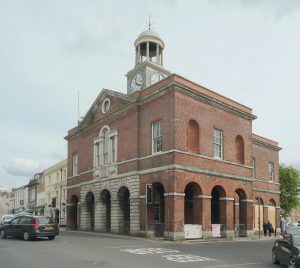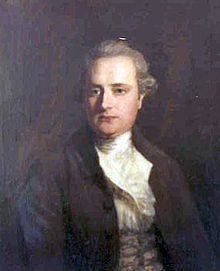October 2022
As the Royal Naval Association holds its Trafalgar Day service on 23 October, our regular contributor Robin Stapleton takes a look at a colourful naval character with a local connection…
Bridport Town Hall’s clock tower and cupola were added about 20 years after the hall itself was built, and were donated by Sir Evan Nepean around 1805.
This seems to be little known, so who was he? Evan Nepean was born in 1752 at Saltash, Cornwall, the son of an innkeeper; he died at Loders in 1822. In between he had a remarkable career, rising to the very top of government service and influence.
Nepean joined the Royal Navy in 1773 at Plymouth as a captain’s clerk and served in the American War of Independence, during which he was promoted to purser. His last navy posting was to HMS Foudroyant, as secretary to Captain John Jervis (later Earl St Vincent). Jervis was impressed by Nepean’s “superior talent for business, unremitting diligence and integrity”.
In 1782, when he was 29, Nepean’s career took an extraordinary meteoric advance; he went from serving as purser on a navy ship to being appointed Permanent Under Secretary of State, Home Department (now the Home Office) by the Prime Minister, the Earl of Shelburne. This was almost certainly on the recommendation of Jervis, who was a close friend of Shelburne. Jervis’s patronage and judgement were to prove well justified.
His responsibilities included:
(i) the Secret Service, spies, political, naval and counter intelligence;
(ii) planning the first convict fleet and making plans to start a colony in New South Wales;
(iii) commissioning botanical expeditions, notably the voyage of the Bounty in the quest for breadfruit as well as the successful second voyage;
(iv) Irish Regulation; and
(v) war and the Colonies, especially Canada. Each one of these responsibilities is a story in itself.
Also in 1782, Nepean married Margaret Skinner, daughter of Captain William Skinner, at the Garrison Church in Greenwich. Nepean’s memorial in Loders Church says they had six sons and two daughters, but records exist for only five of these: Harriet, Molyneux Hyde (later Sir Molyneux, 2nd Baronet Nepean), Frederick, William, and Evan (later the Revd Evan Nepean, Canon of Westminster 1860–73 and Chaplain In Ordinary to Queen Victoria).
In 1794, at a time of heightened tensions, Nepean transferred with the Secretary of State to the new Department of War and Colonies, soon moving on to become First Secretary to the Board of Admiralty in 1795. Along with the Treasury, this was one of the two most senior government positions.
In this post he worked closely with the First Lord of the Admiralty and the Admiralty Commission, who relied heavily on his administrative abilities. There were two First Lords during his tenure, and as it happened one of them was Earl St Vincent, Nepean’s old boss from HMS Foudroyant. The earl thought him the best secretary “since the days of old Pepys of immortal memory”.
The Admiralty office was the centre for naval administration and practically everything that happened there passed through Nepean’s hands. He attended Admiralty Board meetings, which were usually held daily, and drafted or dictated orders and communications. Apart from the most important letters, which were signed by three Board members, Nepean signed these himself. Dispatches received were normally directed to him.
This was the time of the Napoleonic wars, when troops were being massed at Boulogne to invade England (not unlike in 1940) and there were also threats to Ireland. Only the Royal Navy stood against invasion, at the same time protecting trade and the colonies. At times the workload was intense, with messages being drafted, dispatched and received late at night.
While at the Admiralty, Nepean continued his intelligence work, sometimes secretly on behalf of the Foreign Office, employing informants and involvement in a ‘deniable’ plot by French royalists to assassinate Napoleon. The plot was exposed by a double agent with disastrous consequences for the French conspirators who were uncovered.
 In 1799 Nepean bought Loders Court, near Bridport, and on 16 July 1802 was made 1st Baronet of Bothenhampton and Loders in the County of Dorset by King George III. He was admitted to the Privy Council in 1804 and in the same year, to the surprise of many and the consternation of Earl St Vincent, was asked by Prime Minister Addington to fill the vacancy of Chief Secretary of Ireland, which he reluctantly accepted. It was a post to which he was seemingly ill suited. However, that reason needs investigating as none of his three successors stayed any longer in the post than he did. With the approval of the King, he returned from Dublin and was back at the Admiralty as a commissioner within a year. His government career ended in 1806.
In 1799 Nepean bought Loders Court, near Bridport, and on 16 July 1802 was made 1st Baronet of Bothenhampton and Loders in the County of Dorset by King George III. He was admitted to the Privy Council in 1804 and in the same year, to the surprise of many and the consternation of Earl St Vincent, was asked by Prime Minister Addington to fill the vacancy of Chief Secretary of Ireland, which he reluctantly accepted. It was a post to which he was seemingly ill suited. However, that reason needs investigating as none of his three successors stayed any longer in the post than he did. With the approval of the King, he returned from Dublin and was back at the Admiralty as a commissioner within a year. His government career ended in 1806.
Nepean served two terms as MP for Bridport between 1802 and 1812. At that time Bridport returned two members on a small voting franchise! In 1812 he was appointed Governor of Bombay (now Mumbai) by the East India Company, a post he filled for seven years. While in Bombay he was able to advance his botanical interests, corresponding with Sir Joseph Banks (a botanist, a founder of Kew Gardens and president of the Royal Society) and sending seeds and plants. He was elected a Fellow of the Royal Society in 1820.
Finally he was appointed Sheriff for Dorset in 1822 but died later the same year and is buried in the family vault in the nave of Loders church.
There are numerous places named after him in Australia including the Nepean river (which skirts Sydney) dam, gorge and reservoir; Nepean Highway; Nepean Bay; Nepean Point; Nepean National Park with heritage site; Nepean Blue Mountain District; Nepean Island; and others. In Canada, ‘Nepean’ was a town, later designated a city and now a district in Ottawa. Two roads were named after him in Bombay, too.
It seems that throughout his career Nepean was highly regarded for his talents, hard work, diligence and integrity, not least by Prime Minister William Pitt the Younger, Lord Nelson, Earl St Vincent and other prominent individuals. He was also trusted by King George III, who would deal with him direct, unusual for a commoner at that time. Remember, he started life as the son of an innkeeper in Cornwall.
Neapen has a large memorial on the south wall of Loders Church. I am not aware of any other recognition of his remarkable achievements and he seems forgotten to local history, except perhaps in Loders.
Robin Stapleton